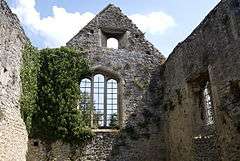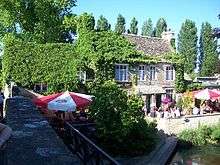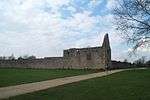Godstow
| Godstow | |
|---|---|
 Godstow Abbey ruins | |
 Godstow Godstow shown within Oxfordshire | |
| OS grid reference | SP484091 |
| District | |
| Shire county | |
| Region | |
| Country | England |
| Sovereign state | United Kingdom |
| Post town | Oxford |
| Postcode district | OX2 |
| Dialling code | 01865 |
| Police | Thames Valley |
| Fire | Oxfordshire |
| Ambulance | South Central |
| EU Parliament | South East England |
| UK Parliament | |
Godstow is about 2.5 miles (4 km) northwest of the centre of Oxford. It lies on the banks of the River Thames between the villages of Wolvercote to the east and Wytham to the west. The ruins of Godstow Abbey, also known as Godstow Nunnery, are here.[1][2] A bridge spans the Thames and the Trout Inn is at the foot of the bridge across the river from the abbey ruins. There is also a weir and Godstow lock.
History
Godstow Abbey (see detailed history below) was built here, starting in 1133. It housed an order of Benedictine nuns. Rosamund Clifford, the mistress of King Henry II, retired here and died at 30. Her grave is somewhere in the grounds but now lost. The abbey was suppressed in 1539 under the Second Act of Dissolution.
The abbey was then converted into Godstow House by George Owen. It was occupied by his family until 1645, when the building was badly damaged in the English Civil War. After this damage, the building fell into disrepair and was used by the locals as a source of stone for their buildings.
This stone bridge was in existence in 1692 and an earlier one was probably that held by the Royalists against Parliamentarians in 1644, during the Civil War.[3] Godstow House itself was fortified as part of the defences of Royalist Oxford against the Parliamentary army at the Siege of Oxford.[4]
By the Thames at Lower Wolvercote and Godstow is a 17th-century public house, The Trout Inn,[5] close to Godstow Bridge. The bridge, in two spans, was built in 1792, the southern span being rebuilt in 1892. Godstow Lock was built here in 1790.
In Victorian times, Charles Dodgson (aka Lewis Carroll) brought Alice Liddell (aka Alice in Wonderland) and her sisters, Edith and Lorina, for river trips and picnics at Godstow.[6]
The ruins of Godstow Abbey were used as a backdrop in the film Mamma Mia! Here We Go Again during the musical number "When I Kissed The Teacher".[7]

History of Godstow Abbey
Godstow Abbey was built on what was then an island between streams running into the River Thames. The site was given to the foundress Edith, widow of Sir William Launceline, in 1133 by John of St. John[8] and built in local limestone in honour of St Mary and St John the Baptist for Benedictine nuns; with a further gift of land from him, the site was later enlarged. The church was consecrated in 1139.
The abbey was again enlarged between 1176 and 1188 when Henry II gave the establishment £258 (which included £100 for the church), 40,000 shingles, 4,000 laths, and a large quantity of timber. Because the abbey was the burial place of his mistress Rosamund Clifford, Henry, who received patronal rights from the nuns, paid special favour to the Abbey.[9]
In 1446 Alice Henley became the abbess and she served until 1470. She is remembered because a "poor brother and admirer" of the abbess created the "English Register".[8] Its purpose was to explain the accounts, in English, to the nuns but it contained other descriptive material and today it illustrates "keeping and understanding records" in English in the 15th century.[10]
The abbey was suppressed in 1539 under the Second Act of Dissolution.
The site consisted of a guest house; a nunnery; an outer court containing a range of buildings; lodging for a priest; St Thomas's chapel, which appears to have been used a church by the Abbey's servants; and the Abbey church, which contained cloisters along with associated buildings. The precincts were entered from the Wolvercote–Wytham road, which ran through the outer court. Here there was a two-storey main gatehouse with a large gate for carts and a second smaller one beside it for foot traffic.
George Price Boyce, the Victorian watercolour painter associated with the Pre-Raphaelite art movement, visited and painted the nunnery in 1862.[11] During the 19th and 20th centuries, the ruined abbey was used for collecting livestock during the annual rounding up of animals on Port Meadow.
Rosamund Clifford's death and grave
The abbey was the final burial place of the famed beauty Rosamund Clifford (died c. 1176), a long-term mistress of Henry II. Henry's liaison with Rosamund became known throughout court in 1174; it ended when she retired to the nunnery at Godstow in 1176, shortly before her death.
Henry and the Clifford family paid for her tomb in the choir of the convent's church at Godstow, and gave an endowment for it to be tended by the nuns. It became a popular local shrine until 1191, two years after Henry's death. Hugh of Lincoln, Bishop of Lincoln, while visiting Godstow, noticed Rosamund's tomb right in front of the high altar. The tomb was laden with flowers and candles, demonstrating that the local people were still praying there. Calling Rosamund a harlot, the bishop ordered her remains removed from the church. Her tomb was moved outside the abbey church to the cemetery at the nuns' chapter house next to it, where it could still be visited; but it was destroyed in the Dissolution of the Monasteries under Henry VIII.
Paul Hentzner, a German traveller who visited England c.1599, records[12] that her faded tombstone inscription read in part:
... Adorent, Utque tibi detur requies Rosamunda precamur.
("Let them adore ... and we pray that rest be given to you, Rosamund.")
Followed by a punning epitaph:
Hic jacet in tumba Rosamundi non Rosamunda
Non redolet sed olet, quae redolere solet.
("Here in the tomb lies a rose of the world, not a pure rose; She who used to smell sweet, still smells — but not sweet.")
Gallery
 Godstow Abbey ruins from the east
Godstow Abbey ruins from the east Godstow Abbey ruins from the south
Godstow Abbey ruins from the south The window of Godstow Nunnery
The window of Godstow Nunnery Ruin of Godstow Abbey
Ruin of Godstow Abbey Approaching Godstow Bridge from the north
Approaching Godstow Bridge from the north Godstow Bridge near Oxford by Edward William Cooke, 1835
Godstow Bridge near Oxford by Edward William Cooke, 1835 Godstow Lock on the River Thames
Godstow Lock on the River Thames The Trout Inn by the Thames at Godstow
The Trout Inn by the Thames at Godstow
References
- ↑ Baggs, A P; Blair, W J; Chance, Eleanor; Colvin, Christina; Cooper, Janet; Day, C J; Selwyn, Nesta; Townley, S C (1990). "Wolvercote: Site and remains of Godstow abbey". In Crossley, Alan; Elrington, C R. A History of the County of Oxford: Volume 12, Wootton Hundred (South) Including Woodstock. London: British History Online. pp. 311–13.
- ↑ Ross, David. "Godstow Abbey, Oxford | History & Photos". Britain Express. Retrieved 7 February 2018.
- ↑ "The Battlefields Trust - The Battle of Godstow Bridge 1644". www.battlefieldstrust.com. Retrieved 2018-02-07.
- ↑ "1643-Royalist Defences at the Beginning of the War - Civil War Oxford". Civil War Oxford. Retrieved 2018-02-07.
- ↑ "Welcome to The Trout Inn". The Trout Inn. Retrieved 7 February 2018.
- ↑ "Alice in Waterland". Oxford Mail. 24 August 2010. Retrieved 8 February 2018.
- ↑ "Mamma Mia! - Oxford firm makes gowns for new film". Oxford Mail. 20 July 2018. Retrieved 7 August 2018.
- 1 2 "English Register". 1450. Retrieved 7 June 2017.
- ↑ Amt, Emilie (19 September 2014). "Eight myths about Fair Rosamund". OUPblog. Retrieved 7 February 2018.
- ↑ Orme, Nicholas (2004). "Henley, Alice (d. 1470)". Oxford Dictionary of National Biography. Oxford University Press. Retrieved 7 February 2018. (Subscription required (help)).
- ↑ Godstow Nunnery, Oxfordshire by George Price Boyce, 1862. (Sold at Sotheby's, London, 2001.)
- ↑ Hentzner, Paul (1892) [1797]. Travels in England during the reign of Queen Elizabeth. Cassell & Co.
Further reading
- Crossley, Alan; Elrington, C.R. (eds.); Baggs, A.P.; Blair, W.J.; Chance, Eleanor; Colvin, Christina; Cooper, Janet; Day, C.J.; Selwyn, Nesta; Townley, Simon C. (1990). Victoria County History: A History of the County of Oxford, Volume 12: Wootton Hundred (South) including Woodstock. pp. 311–313.
- Page, William, ed. (1907). Victoria County History: A History of the County of Oxford, Volume 2. Archibald Constable & Co. pp. 71–75.
- Royal Commission on Historical Monuments (1939). City of Oxford. HMSO.
- Sherwood, Jennifer; Pevsner, Nikolaus (1974). The Buildings of England: Oxfordshire. Harmondsworth: Penguin Books. p. 852. ISBN 0-14-071045-0.
